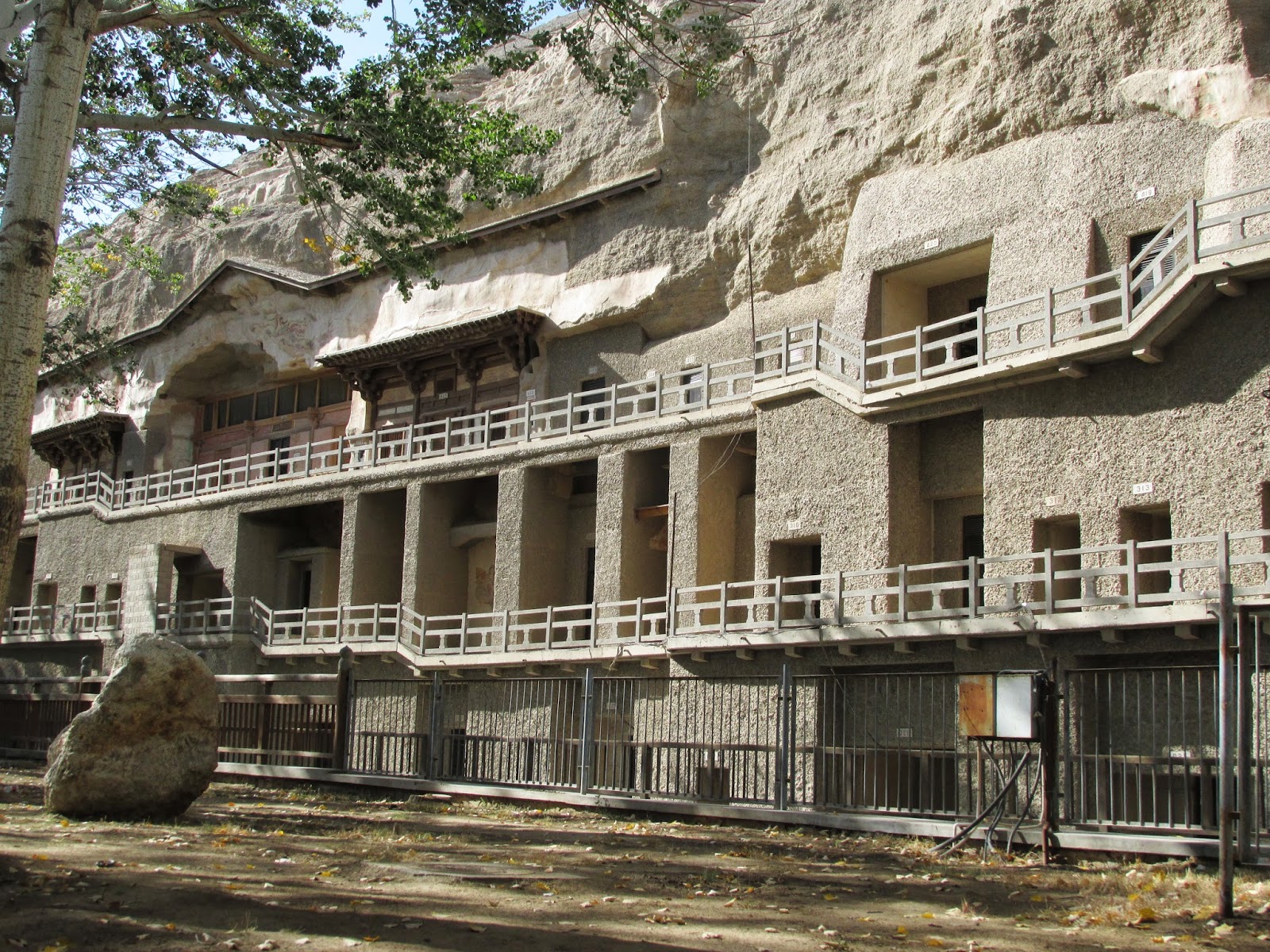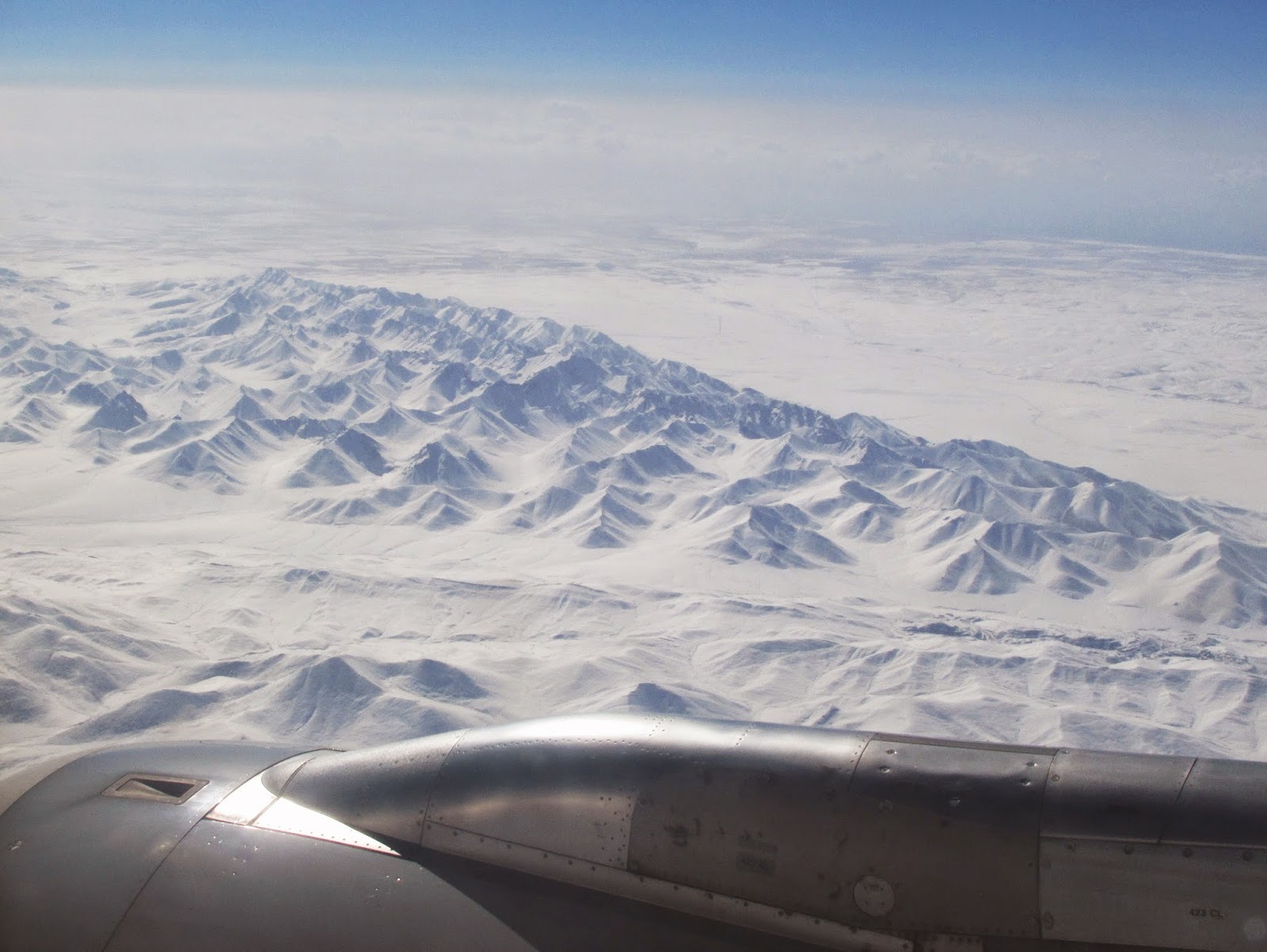Thursday’s
destination was the famous Mogao Caves, which is famous for the beautiful
paintings on the cave walls. They are also known as the Caves of a Thousand
Buddhas because some of the caves have 1000 Buddhas painted on the walls. The
bluff is about 1.7 km long and has 735 caves carved into it. The caves were
carved out and decorated from the 4th to the 14th
centuries. One section of 248 caves was for monks who lived there or meditated
there.
The larger section of 487 caves were carved and decorated by donors—merchants and nobles who hired artists to do the work. Creating a cave could take up to 25 years.

The caves have paintings on all walls and the ceiling.
Some have statues.
These were made from a wooden frame that was covered with straw and then covered with clay and painted. Many of the paintings are original; some have been restored over the years, including during later dynasties. Some of the paint was made from minerals, such as lapis lazuli, and these pictures are still brilliant. The site is truly magnificent, awesome, and amazing.
The larger section of 487 caves were carved and decorated by donors—merchants and nobles who hired artists to do the work. Creating a cave could take up to 25 years.

The caves have paintings on all walls and the ceiling.
Some have statues.
These were made from a wooden frame that was covered with straw and then covered with clay and painted. Many of the paintings are original; some have been restored over the years, including during later dynasties. Some of the paint was made from minerals, such as lapis lazuli, and these pictures are still brilliant. The site is truly magnificent, awesome, and amazing.
The first stop when going to the caves is the Visitors’ Center. Charley had called and been told that there are English-speaking guides at 9:00 and 1:00. When I arrived for the latter tour, I was told that there were only Chinese-speaking guides. I told the woman, who spoke English well, that the man had called and been told that there would be an English-speaking guide at 1:00. She made a phone call and then told me that one would be available at 1:30, which was fine with me.
Another
woman took me to see the films. She explained that, unfortunately, I was only
able to see the second film, as I had arrived too late for the first one and it
wasn’t being shown again for an hour. The second film was a surrounding, 3-D
film featuring the artwork in the caves. Sitting in the theater was like being
in a cave surrounded by the magnificent artwork. I’d been in 3-D presentations
before but not one this dramatic. I took a few photos, as did my neighbors,
before we were told that photos were not allowed.
After
the film, we all took the shuttle to the site where I was met by a man who told
me to wait for ten minutes. Then my guide arrived. She speaks English very
well. Her presentation was obviously by rote, but when I asked questions, she
answered naturally. Sometimes it’s OK to have a Chinese-speaking guide, but at
this site I was glad to have one who speaks English well so that I could
understand and not only appreciate the art. Another advantage was that
sometimes we were alone in the caves before the next group of 20 arrived.
We visited seven caves. The one they call the Crown Jewel has the third largest Buddha in China. Another important cave is the library where thousands of manuscripts were stored and not discovered until the 20th century.
One cave is shaped like a coffin and has a reclining Buddha. Ceiling peaks have geometric paintings. The bodhisattvas in some caves are greatly influenced by Indian art styles.
We visited seven caves. The one they call the Crown Jewel has the third largest Buddha in China. Another important cave is the library where thousands of manuscripts were stored and not discovered until the 20th century.
One cave is shaped like a coffin and has a reclining Buddha. Ceiling peaks have geometric paintings. The bodhisattvas in some caves are greatly influenced by Indian art styles.
Most of the caves are not open to the public in order to preserve them. The doors are locked and opened by the guides when groups enter. I noticed that groups do not all go to the same caves, except the few big, famous ones. This is also to help preserve them, as having large groups breathing and sweating in the caves brings in moisture that can eventually damage the paintings. There is no lighting in the caves; guides point out features using their flashlights. Knowing that photos are not allowed, I photographed post cards and downloaded some photos from the Internet.
After
visiting the caves, I went to the museum at the site. It has some of the
ancient sutras and some pieces of silk found in the caves. It also has
reproductions of several small caves. I became one of the attractions for three
men who were surprised to see a foreigner. One asked for a photo, and another
did, too, after learning that I am American.
Friday was my extra day. Since planes to Chengdu leave only on Tuesday, Thursday, and Saturday and I didn’t want to return on Thursday, I made the reservation for Saturday knowing that there would be extra time in Dunhuang. Since I’d seen the sites I wanted to visit, there was only one other place I had considered: White Horse Pagoda. When I asked about getting to the pagoda, Charley suggested that I could walk and gave me directions. It was only about a mile from the intersection in town to the village where the pagoda is. An easy walk. I’d read that each level of the pagoda is different and thought that meant that you can go inside and walk up, enjoying the different levels. But it meant that the outside levels were different. This is not a pagoda you can go into.
More affluent families have a glass roof over the central area. In villages I’ve visited, I have found that the doors seem to indicate the wealth of the family.
One house had the shelters for crops that I’d seen from the bus and train. So I finally got to see them close up.
I also saw a field of grape arbors, which I’d seen from the camel.
On a different path back to the city, I came across the Relic Site of Shazhou Ancient City. The sign had dates in the 8th and 13th centuries, which is all I could read on the Chinese sign. Back in the city, I ended out at the Night Market again and had a bowl of chicken noodle soup.
Friday was very cold. Charley said it was -3o C/27o F in the morning and was to get up to 9o C/48o F. It was warmer for about three hours in the afternoon before I had to put on my hat and gloves again. I was really glad to have gone to the dunes and done the camel trekking on days with better weather.
I like
Dunhuang. It’s a small city by Chinese standards and is fairly quiet—not much
traffic. I was glad I had stayed near the dunes and not in the city even though
I probably could have had a room with heat had I chosen a more expensive hotel
in the city. After the first two days, I was the only guest at the guesthouse;
so it was very quiet. I liked being able to see the dunes from the window—just
a little— and from the courtyard, and I liked staying in an old-style house.
Dunhuang
is known for grapes and apricots. The dried fruit vendors have several kinds of
grapes. They also sell dried apricots. Another apricot product is a drink they
call apricot tea. I had it first at the dunes Scenic Area and liked it so much
that I bought several more cups to carry around with me. Charley told me that
grapes, apricots, and cotton are the main crops.
Saturday
I flew back to Chengdu. The flight went along the high, snow-capped mountains I
had seen in Jiayuguan. I had an aisle seat, but when I asked the man at the
window to take a photo for me (after he had taken one himself), he and his
friend moved so I could sit at the window. That was really nice, and I enjoyed
viewing the mountains most of the way to Lanzhou. After the layover in Lanzhou,
we returned to our original seats.
It was
a short but very enjoyable holiday trip. I’m glad I was able to do it. In class
the next week, I shared photos of what I did while students were at military
training. They all enjoyed that.



















No comments:
Post a Comment